General Relativity
As Nobel Physicist John Wheeler once put it
If you are not completely confused by quantum mechanics, you do not understand it.
The same may be said for general relativity.
Light, Gravity, and Elevators
Einstein's Special Theory did not explain gravity, but it created a framework for understanding space and time. The General Theory of Relativity provides a description of gravity quite different from Newton's. It rests on a simple idea:
Gravity and acceleration are equivalent and cannot be distinguished.
As a consequence, in a freely falling elevator or spacecraft you do not feel gravity and seem "weightless", although gravity from the Earth is still present. Astronauts working on the Hubble Telescope do not experience gravity because they are falling freely as they orbit Earth. On the final Hubble repair mission astronauts will feel weightless as they prepare the telescope for 5 more years of use. Gravity will be pulling on them, keeping them in orbit around Earth, and their acceleration will cancel gravity from their point of view.
In an elevator such as shown here, the beam of a flashlight will behave differently depending on the motion of the elevator, at rest, at constant velocity, or accelerating.
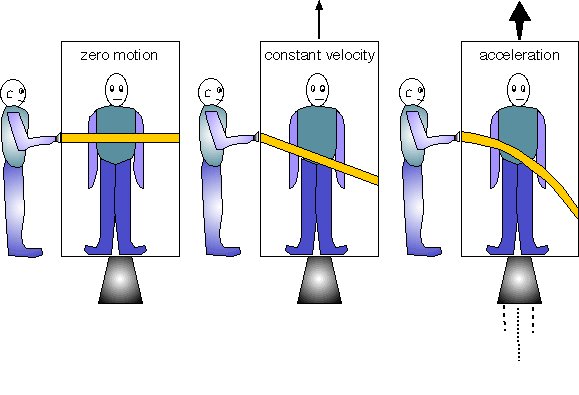
Three different views from inside an elevator of a beam of light projected by a person outside. On the left, the elevator is stationary with respect to the outside source. In the center, the elevator is moving upward at a constant speed. On the right, it is accelerating upward. Credit: Nick Strobel
Near Earth's surface, gravity accelerates mass at 9.8 meters/second each second (9.8 m/s2). Drop a ball, and for each second of fall the ball speeds up by 9.8 meters/second. According to the principle of equivalence, if an elevator far out in space accelerates at 9.8 m/s2, the person inside will feel the same as he would if he were standing on Earth. The acceleration cannot be distinguished from gravity.
Imagine first a beam of light when there is no motion such as the image on the left. Inside the elevator, the beam goes straight across and strikes the opposite wall. It follows a straight path parallel to the floor.
If the elevator is moving at a constant speed, then it goes up while the beam moves toward the wall. Seen from inside, the beam slants down toward the floor such as in the image in the center. The effect is small because light is so fast, but if the elevator's speed is high enough, the person inside notices that the beam moves lower as it crosses the cabin.
If the elevator is accelerating, then while the beam makes its way across, the upward speed of the elevator increases. The acceleration causes the path the light follows to curve downward.
Since acceleration and gravity have equivalent effects, it must be that gravity also curves the path of light.
Sun's Gravity Bends Starlight During the 1919 Total Solar Eclipse
The 1919 total solar eclipse offered an opportunity to measure the apparent positions of stars whose light passed near the Sun. Einstein predicted that just as acceleration causes light to appear to follow a curved path, gravity would also bend beams of light from stars as the light passed close to the Sun. This is how he sketched what would happen in letter he wrote to American solar astronomer George Ellery Hale in 1913, urging a measurement of the effect. The small angle, 0.84 seconds of arc, is the change arising from Newton's theory of gravity. Einstein's theory of General Relativity was published 3 years later, in 1916, predicting twice the "classical" value.

The Sun's gravity would bend a beam of starlight from its normal position in the sky. This was proven by Sir Arthur Eddington using images taken during the last moments of the 1919 total solar eclipse. When he compared his photograph taken at the time of the eclipse to one taken 6 months earlier without the Sun, he found that the Sun deflected the star's light by 1.61 seconds of arc as predicted by the General Theory of Relativity.
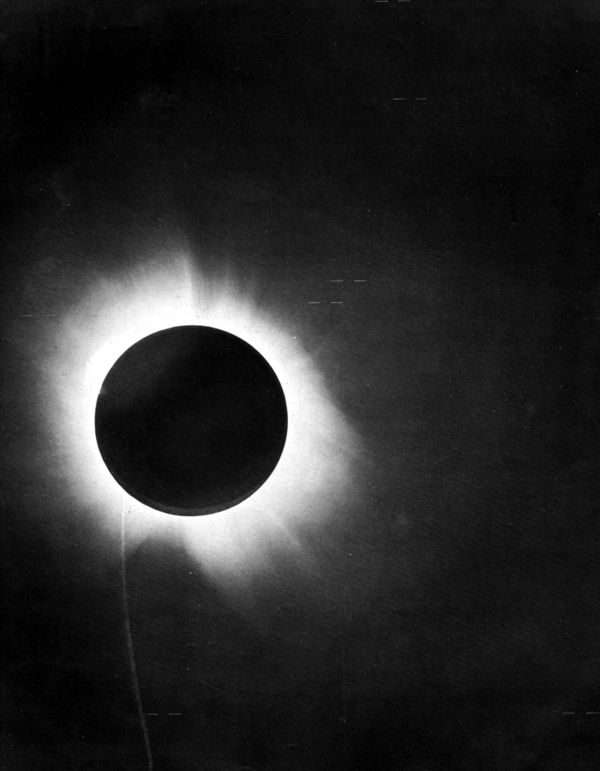
Photographic plate of the 1919 eclipse with stars marked
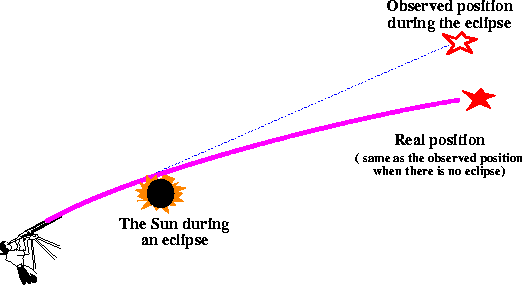
How the Sun bends starlight
General Relativity explains gravity in an entirely new way. In Einstein's view, gravity is a distortion of space and time caused by mass. We'll see that time runs slower when there is mass present. The bending of the path of starlight near the Sun occurs because the Sun curves the spacetime through which the starlight passes.
In 1976 to 1977, when Mars was on the far side of the Sun seen from Earth, radio signals between the Viking spacecraft on Mars surface and stations on Earth passed very close to the Sun. The signals were delayed by the effect of the Sun's gravity on spacetime, and the measurements matched the prediction of General Relativity to within 0.1%.
Mercury's Orbit is Influenced by the Relativity of Sun's Gravity
According to Newton, if they Sun were a perfect sphere and there were no other planets in the solar system Mercury should orbit the Sun in a perfect ellipse, and repeat the same elliptical path every 88 days. When Einstein was working on General Relativity, astronomers knew that Mercury's orbit precesses. Its ellipse turns slowly around the Sun over a 225,000 year cycle. The orientation of the axis of the ellipse shifts 574 seconds of arc (0.16 degrees) each century. Most of the effect had been explained by the gravity of the other planets, but Newton's gravity could not explain 43 seconds of arc per century of the precession.
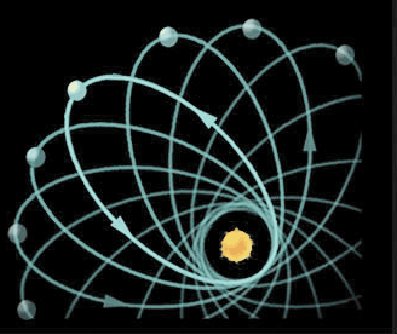
Precession of Mercury's Orbit
Astronomers looked for undiscovered planets close to the Sun, to account for the missing 43 seconds of arc, but none were found. The answer came instead from the mind of Einstein, with his idea of the distortion of space and time by the Sun's mass. It precisely predicts the missing 43 seconds. Einstein described his discovery --
For a few days, I was beside myself with joyous excitement
Gravitational Lensing
Just as starlight is bent around the Sun, the light from distant galaxies is bent around matter on its way across the Universe.
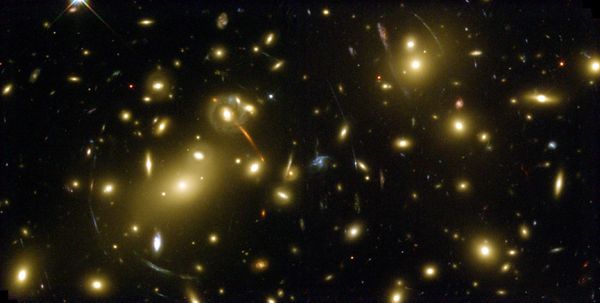
Gravitational lensing of distant galaxies by a cluster of galaxies Abell 2218
Credit: NASA, STScI
The cluster of galaxies Abell 2218 is 2 billion light years away. It is so massive that its distortion of spacetime deflects light from even more distant galaxies to form images of them as the arcs seen throughout this picture. The galaxies seen in the arcs are 5 times farther away than the cluster, and appear as they were when they were much younger than the galaxies we see in the cluster itself.
Sometimes a distant quasar can be imaged by a single intervening galaxy. In this image the central cloverleaf is light emitted by a background quasar, aligned behind the center of the galaxy.
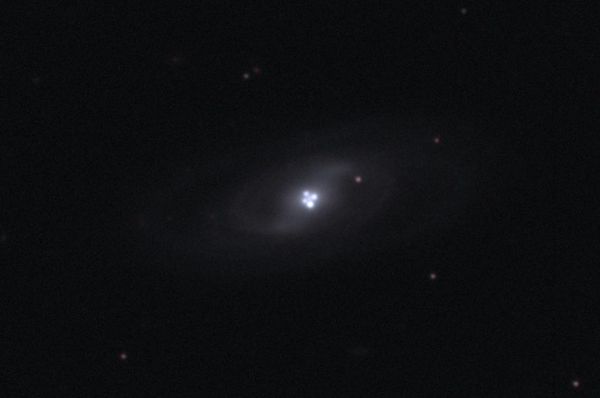
Einstein Cross - A gravitational lens forms multiple images of disant quasar
Individual stars can act as gravitational lenses too. Astronomers use the effect to search for planets around the intervening star. Our own galaxy is so dense with stars, that as they orbit around the galaxy we will see them pass in front of each other. When this happens, within a few days the closer star will act as a lens and the image will brighten because of the added light from the more distant star.
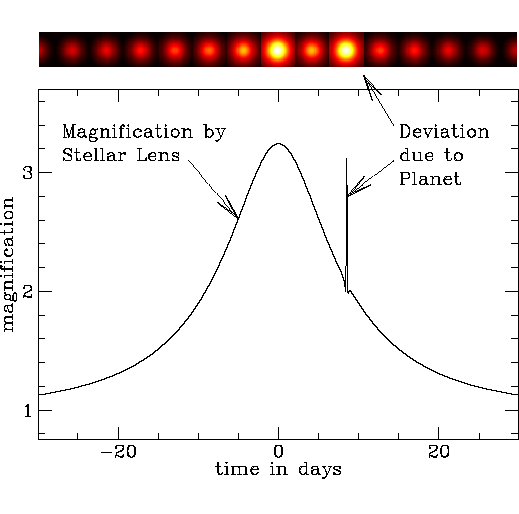
If there is a planet around the closer star, the planet's gravity will also create a lens. The sharp spike in this graph tells where the planet is and how big it is by the way in which the light brightens. There is a global network of telescopes searching for these "microlensing" events to use gravitational lenses to find "extrasolar" planets.
Gravitational Waves
When a mass moves, it creates ripples in spacetime that spread at the speed of light. The effect is like ripples on a pond, where the "pond" for gravitational waves is the spacetime of the entire universe. We have seen the indirect effect of gravitational waves in the effect of the energy they carry away from rapdily rotating neutron stars. Experiments are underway now to see the waves directly by detecting them with masses here on Earth with the Laser Interferometer Gravitational-Wave Observatory (LIGO).
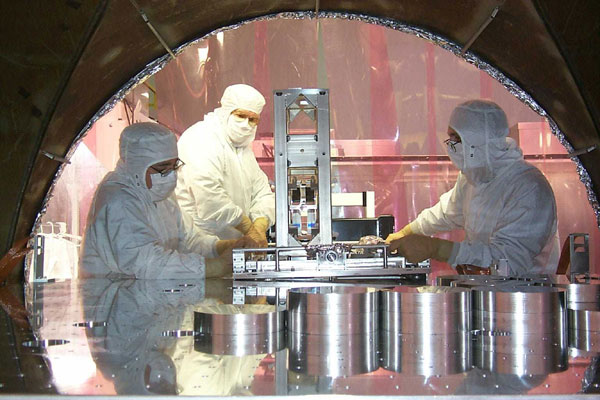
Technicians placing a mirror in the LIGO gravitational wave detector
When gravitational waves pass through LIGO's detector, they ripple spacetime, and change the distance between mirrors attached to test masses. The movement of the mirrors is detected by a laser. The system is so sensitive that micro-earthquakes or other nearby events create a constant background noise. LIGO has two detectors, one in Washington state, and another in Louisana, separated by 3200 km (2000 mi). The scientists are looking for events that occur simultaneously at both sites.
Gravity Near Black Holes
Since gravity is the effect of mass on spacetime, we might picture its spatial effects this way
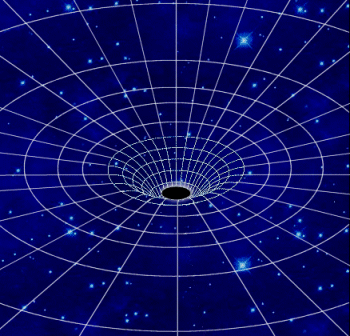
Visualizing gravity's effect on space
There is an effect on time too, and clocks near a large mass run slowly compared to those farther away. Even near Earth, a clock will slow down if you move it from the attic to the basement (not by much, but it can be measured!).
Features in solar spectra appear to us slightly shifted to the red , at a lower frequency, compared to the same ones here on Earth because of the gravitational time dilation . The atoms that make the spectral lines are clocks, ticking off time on the Sun. When those clocks run slow, the spectral lines from the atoms are reddened, at a lower frequency. The gravitational redshift has been seen on white dwarf stars too, where it can be larger than it is for the Sun because the mass is compacted into a smaller star.
It is possible to make an object so small that nothing, not even light, can escape. A black holes might look like this seen from a safe distance.
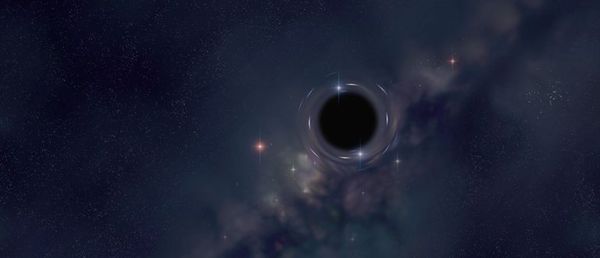
A quiet black hole with the Milky Way in the background. There is gravitational lensing of the light from the galaxy behind it.
To escape completely from the pull of gravity of planet, star, or black hole you would have to start with enough energy of motion to climb out of the "well". This determines the escape velocity, the minimum speed it would take to get away. For instance, to send a satellite beyond Earth we have to give it a speed of about 11 km/s. To escape the solar system from Earth's orbit takes 42 km/s, but to escape from the surface of the Sun takes 617 km/s. The escape velocity from R is
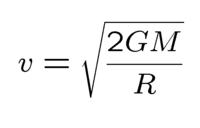
G is the constant of gravitation, which sets the strength of gravity in the universe. If R is very small, or if M is very big, it is possible for the escape velocity to be bigger than the speed of light. Matter cannot travel that fast. This means there must be objects so massive and so small that light cannot escape from them. That's a black hole.
To make a black hole the mass must all be inside a distance to make the escape velocity the speed of light. This distance is known as the Schwarzschild radius, after the astrophysicist who recognized the possibility even before Einstein completed General Relativity. The distance is
RS = 2 G M / c2
For the Sun's mass this works out to be only 3 km. Take all the mass of the Sun, put it inside a sphere just 3 km in radius (about 2 milies), and it would be a black hole.
Outside that radius matter can orbit or escape, but there is no escape from inside. The activity that we see from black holes in galactic nuclei such as this one comes from matter flowing in, releasing the energy gained by acceleration in the strong gravitation.
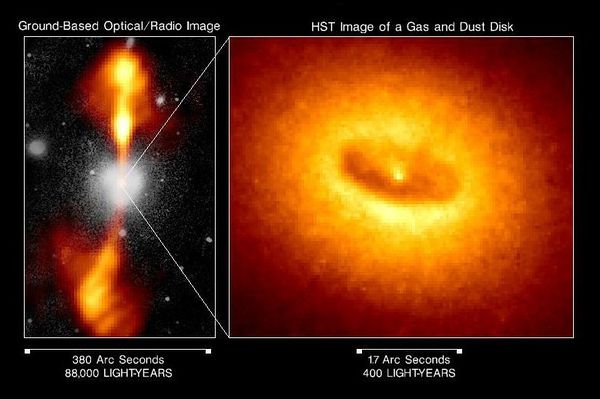
An actively feeding black hole
Black holes do not "gobble up" matter, although matter does disappear into them. If you were so unfortunate as to fly a spaceship toward one, you could still turn around and fly out until you crossed the Schwarzschild radius. At that boundary you could no longer communicate with the rest of the universe, and you could not turn back. Try to send a photon straight out to signal your dire situation, and it will lose all of its energy before it clears the radius. Send the photon at an angle and it will orbit the black hole. The outside universe cannot tell what is inside. All we know is that the black hole has mass, that it may be rotating, and that it may be charged.
Those of us outside watching you fall in would never see you reach the boundary. The closer you are to it, the more redshifted light from you will appear. It will seem to us that your clocks are slowing down, that time is stopping for you, as you reach the point of no return.
At the center of the black hole is the singularity, an infinitely small point of infinite density. It is hidden from us by the event horizon, the boundary defined by the Schwarzschild radius. We know now that suprmassive black holes exist in the nuclei of galaxies. One in the Milky Way is more than a million times the mass of the Sun, and there are larger ones in other active galaxies. There are also stellar mass black holes that result from a supernova and collapse of an evolved star. We think that these stellar mass black holes can merge in dense stellar environments like globular star clusters. Supermassive black holes are linked to the formation of galaxies, and one suggestion currently being explored is that they came first, formed in the primordial universe, and were the seeds about which galaxies grew.